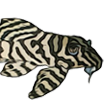Originally had two (no spawning activity) adults, but recently added two more.
They spawned the night the latest two were added.
Spawning took place at night.
The eggs took 3 weeks
Conductivity was about 250us and pH about 6.8.
Feeding young on pre-soaked and crushed Tetra Prima.
Fry in net breeding trap with two filter outlets directed at mesh (one with UV).
Lost five out of twenty-four fry (1 week old).
Male is now brooding another clutch of eggs.
Here are pics:
Male with egg-mass:

Fry at 1 week old (15mm):

Fry net:

Set up:




















